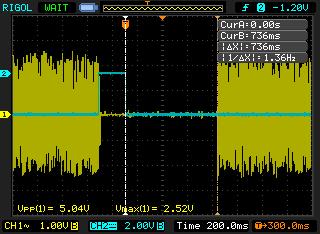This is a follow up to A Brief Review of the KT-8900D
Testing Turn-around Time
One of the key metrics when evaluating a radio for packet use is turn-around time. This is the time it takes for the radio to switch from transmit to receive. The turn-around time for a packet radio needs to be fast in order to hear responses from the other packet stations. Most packet stations and digipeaters will reply within a few tens to a few hundred milliseconds from the time it received the packet. When a radio takes more than 50-100ms to turn around, it will be difficult to catch the start of the packet, sync with the preamble and decode.
Turn-around time has not been an issue for ham radios for quite some time. The turn-around time for most modern ham rigs is very fast, typically well under 100ms. For reference, the turn-around time for the Kenwood TM-V71A is about 20ms.
Turn-around time has only become an issue again recently with the advent of RDA1846-based radios.
Test Setup
To test turn-around time, the KT-8900D was connected to a dummy load and to a Jetstream power supply. It was powered on and set to low power. STE, RP-STE and RPT-DL were turned off. The unit’s microphone was plugged into its RJ-45 socket.
To perform the test I set up a test harness on a breadboard. I plugged one end of a cable into the radio’s rear 3.5mm speaker/mic connector and the other end into a jack mounted on the breadboard. I connected the sleeve of the jack to ground and connected the scope’s channel 1 to the audio output and channel 2 to the PTT line.
The PTT line sits at -3.3V and is grounded to trigger PTT. I set the scope to trigger on the downward edge of the PTT signal (CH2). I triggered PTT by manually shorting the PTT signal to ground and by using the hand-held mic. The hand-held mic gave the best results, with no bounce and lower turn-around time.
I steadily increased the time base on the oscilloscope starting from 1ms until I was able to capture the start of the audio signal.
The Results
So here is the horrible truth about the KT-8900D turn-around time.
700ms turnaround time. This radio isn’t going to just miss the start of a packet — it’s going to miss the entire thing. This is bad. Really bad.
This is worse than the Baofeng UV-5R, which has a measured turn-around time of 300ms.
This radio is wholly unsuitable for packet work, including APRS.


